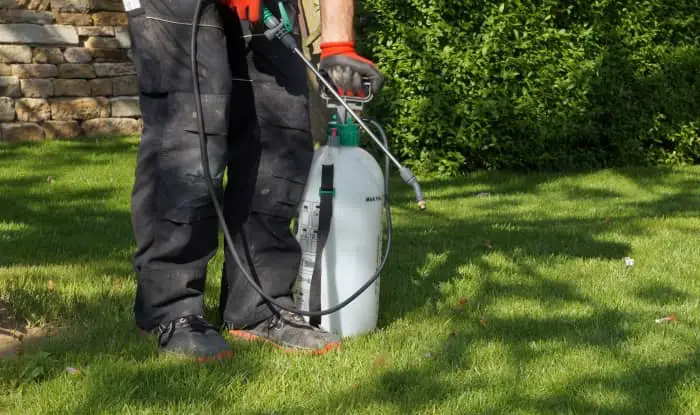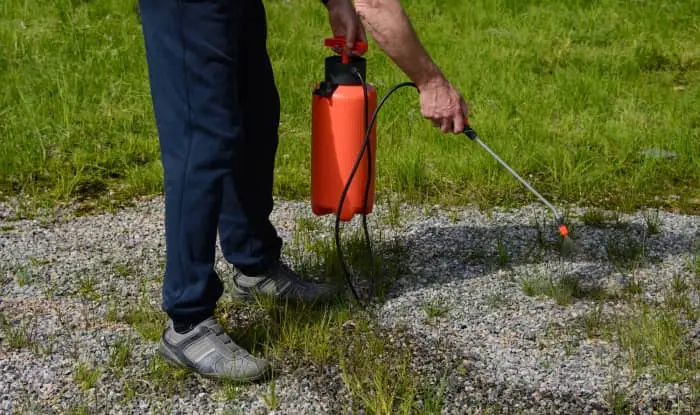With so many types of weed killers available on the market, choosing the right one can be confusing.
So in this guide, I’ll give you a breakdown of the differences between the types and what it’s best to use them for.
The following are the main types of weed killer: contact, systemic, selective, non-selective, residual, post-emergent, pre-emergent, chemical, and organic.
A weed killer can combine several of these types. For example, the well-known Roundup is a post-emergent, non-selective, systemic, chemical weed killer.
Let’s look at each type in more detail.
Contact Weed Killers
Contact weed killers kill the parts of the plant that the weed killer makes contact with. They work quickly. But make sure the weed is well-soaked for the best results.
Contact weed killers are good at killing the weed above the ground. But some weeds will grow back because they usually don’t affect the roots, bulbs, and tubers. So you might need to apply the weed killer more than once. Repeated applications will exhaust the root system and prevent the weed from regrowing as it can no longer photosynthesize.
Some weed killers combine a contact weed killer with a systemic weed killer. This gives you fast results and kills the root system to prevent the plant from growing back.
Systemic Weed Killers
Systemic weed killers are absorbed through the foliage. Once inside, they are carried around the weed’s vascular system to every part of the plant.
As they work their way around, systemic weed killers interfere with biochemical processes inside the plant. Disrupting protein and chlorophyll synthesis.
Because every part of the plant is killed by this type of weed killer, including the roots, the weed is prevented from regrowing. But this process takes longer than the rapid effect of a contact weed killer. You’ll often have to wait several days to start seeing results. And it might take 2-3 weeks for a complete kill.
Examples of systemic herbicides are glyphosate and 2,4-D.
Selective Weed Killers
Selective weed killers are formulated to kill specific types of plants while leaving others in good health. Lawn weed killers are usually selective weed killers.
These types of weed killers target broadleaf weeds, and specific species of grassy weeds, while leaving most common types of turfgrass unharmed.
Non-Selective Weed Killers
Non-selective weed killers are the best choice when you want to kill all the vegetation growing in an area. Be very careful when using this type of weed killer around desirable plants. Try to shield them with cardboard if spraying nearby. And wash the weed killer off immediately if it accidentally gets on the plant.
It’s a good idea to make sure that it’s not windy when using a non-selective weed killer, as it can be hard to stop the spray drifting onto nearby vegetation that you don’t want to kill.
Residual Weed Killers
Residual weed killers are also sometimes called persistent weed killers. This type of weed killer stays in the soil after it’s applied, preventing new plants from growing for up to a year or more.
Long-lasting residual weed killers are best used in areas where you don’t want anything to grow. Such as around building foundations, gravel paths, car parks, and between paving and patio stones.
For agricultural purposes, you can get residual herbicides that are selective and will control certain weed species while allowing the crops to grow.
Residual weed killers have pre-emergent activity. They prevent weed seeds from sprouting and developing into seedlings. You can get pre-emergent herbicides that have a narrower period of residual activity for use on lawns and around gardens.
Pre-emergent Weed Killer
What do you do if the weeds in your yard have already dispersed seeds? You can kill the existing plants with a post-emergent weed killer. But, the weeds will reappear in your garden during the next growing season when the seeds germinate.
To deal with this problem, you need a pre-emergent herbicide. When applied to the ground at the right time of year, a pre-emergent herbicide will stop weed seeds from sprouting after germination. This is an often overlooked, yet crucial ingredient in keeping your yard weed-free.
The best time of year to use a pre-emergent herbicide depends on the type of weeds in your garden. Some weeds germinate in the spring, whereas others germinate in the fall. You want to apply a pre-emergent herbicide to the ground within a couple of weeks of their germination time.
Post-emergent Weed Killer
Post-emergent weed killers kill weeds that are already growing in your garden. There are various types of post-emergents. They can be contact or systemic, selective or non-selective.
But unless they are residual, these types of weed killers won’t stop new weeds from sprouting if there are seeds in the soil waiting to germinate.
Chemical vs Organic Weed Killer
Most commercial weed killers are chemical weed killers. They are usually very effective. And sometimes specially formulated to kill specific types of weeds that you may be having a problem with.
But not everyone likes spraying chemicals in their yard. So instead, you can use organic herbicides such as high-strength vinegar. You often still need to take care when spraying these pet-safe weed killers. But after they dry, you don’t have to worry about chemical residues in areas that children and pets like to play in.
But organic weed killers also have some downsides. Firstly, they are non-selective. So they will kill your grass as well as the weeds. And they often work on contact. So they don’t kill weeds to the root. They also usually work out more expensive to use over large areas than chemical herbicides.



